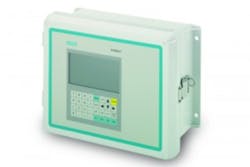A suburban township in the upper Midwestern U.S. buys its drinking water from a major municipal water district. The township’s water distribution system network has four connections to the larger municipality’s water transmission main. The municipality has many wholesale customers and has implemented contracts with each customer to limit the peak flows and the time of day in which they may occur. If customers exceed the limit, they are assessed significant surcharges.
These potential surcharges make it essential for wholesale customers to manage water demand prudently. As a result, many customers invest in solutions to minimize usage peaks and control the time of day that they occur, including elevated water storage towers and control valves at each connection to the transmission main.
Challenge
The major municipal water district owns and operates "metering pits" with electromagnetic flowmeters (magmeters) immediately upstream of the control valves owned by each customer. However, as a rule, the signals from these meters are not made available to any customers on a real-time basis. Wholesale water customers are only provided with datalog summary reports from these meters on a routine schedule for billing purposes.
Without a method of measuring flow or receiving timely flow rate data from the water district, the suburban township had no means of knowing, in real time, the amount of water they were drawing from the transmission main. Therefore, they did not know if or when they were exceeding the contractual peak flow rate limits and incurring significant surcharges from the water district until they were billed.
The township needed to determine the flow rate at each of its four connections to the transmission main so that it could control how much was being drawn at each site. It also needed to know the total flow from the municipality’s transmission main so that it would not exceed its contractual peak demand.
The control valves were initially installed without flowmeters. The intention was to use valve position and upstream/downstream (differential) pressure readings to estimate the flow using the characteristic curve of the valve. However, this proved to be too complicated and cumbersome for the township‘s Supervisory Control and Data Acquisition (SCADA) system to implement effectively.
Solution
This clamp-on ultrasonic flowmeter model helped a Midwest township avoid peak limit surcharges.
The township and its engineer worked with a local representative of a major manufacturer to find a solution to measure the flow rate and totalize the volume of flow at each of the customer’s control valve sites. The most significant challenge was the piping configuration, as all of the valves were previously installed without proper spacing for a flowmeter.
The manufacturer representative used a clamp-on ultrasonic flowmeter kit to demonstrate the technology to the customer and prove that it would reliably meet their objectives. The valve with the worst piping configuration was selected for the demonstration, with the assumption that if the flowmeter would work for the worst site, it would work at the other three sites as well. If the flowmeter did not work for that site, the township would need to consider alternate and more costly flow measurement technology.
Once installed, the meter provided reliable readings right away. The unit was allowed to log for a period of three days. After that, the data was retrieved and compared to the readings from a competitive magmeter in the municipal water provider’s metering pit. The logger on the clamp-on flowmeter helped establish that the meter would work for these applications.
The clamp-on ultrasonic flowmeter commissioned by the water authority can operate in either transit time or Doppler mode, eliminating the need to change the meter when operating conditions change. This makes it suitable for many types of liquids, even those with high aeration or suspended solids. Other applications include raw and potable water, effluent, condensers, chillers, nuclear, process control and batching.
Benefits
Cost savings
If the customer were unable to use the clamp-on ultrasonic flowmeters, it would have had to excavate and install a below-grade vault to house a magmeter and associated isolation and bypass valves, along with conduit and wiring, at each of the four sites. This would have required cutting the water pipe and going through a cumbersome disinfection process, both of which would have required lengthy permitting and costly testing. Further, some of the sites had little or no room to accommodate such modifications. It was estimated that this work would have totaled more than $250,000. In comparison, the customer ended up spending $25,000 for the clamp-on meters along with field service to install some conduit from the pipe to an existing above-grade SCADA panel.
Time savings
The customer had already made improvements to the distribution system and installed four new control valves. However, its construction contracts were closing, and it could not use its water tower until the new flow controls were added, making time a critical factor. The customer saved three to six months by using the clamp-on flowmeters instead of constructing new vaults to house magmeters.
Improved process reliability
Now that the meters are in place, the customer can control how much water it is taking from the water district at each of the four locations and ensure it does not exceed the contractual peak. In addition, it can now properly manage the fill and draw of its elevated storage tank to offset peak demands and during periods of low demand.
Martin Dingman is the product manager for Siemens Industry Inc.’s U.S. clamp-on ultrasonic flow products. With more than 20 years of experience in the process measurement and instrumentation industry, Dingman has held roles in product marketing, manufacturing, engineering, project management and sales. In his current role, he is responsible for all strategic development, product marketing and product management issues associated with clamp-on ultrasonic flow products. For more information, visit usa.siemens.com/industry.



